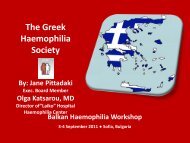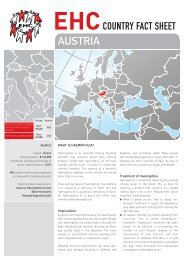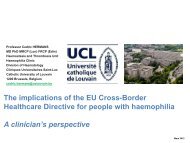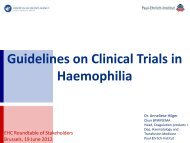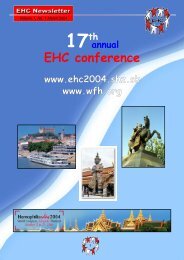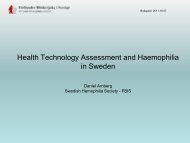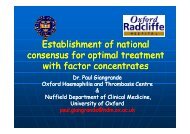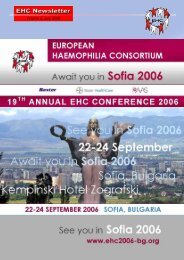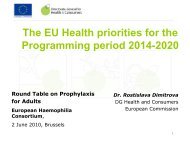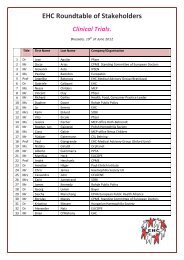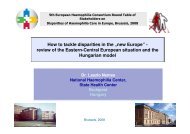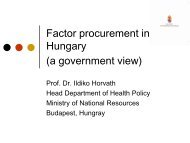2010 November - EHC
2010 November - EHC
2010 November - EHC
Create successful ePaper yourself
Turn your PDF publications into a flip-book with our unique Google optimized e-Paper software.
Study results support his view. As demonstrated in Italy and the UK, secondary prophylaxis was<br />
effective in preventing total bleeds and joint bleeds in adults with severe haemophilia . Access to<br />
prophylactic therapy is also one of the European Principles of Haemophilia Care.<br />
Whereas some benefits, for instance “missed work days”, are easily measurable and can be<br />
balanced with costs, others are not. Avoidance of pain and suffering, the pursuit of an education<br />
or career, raising a family, enjoying normal activities, the ability to travel and freedom from<br />
anxiety and restrictions – the list of benefits without a price tag is long. Brian O’Mahony<br />
concluded his presentation by commenting: “We need to work to ensure that governments,<br />
health ministries and health economists focus on the value of haemophilia treatment in addition<br />
to cost.”<br />
Expert Meeting on von Willebrand disease on Åland Islands<br />
Thirty-eight experts from 18 countries gathered on the Åland Island Meeting to discuss the treatment<br />
and science of von Willebrand disease on 22nd- 25th September, <strong>2010</strong>, on invitation of Prof. Erik<br />
Berntorp, University of Lund, Sweden with financial support from Octapharma .<br />
One of the first patients described with von Willebrand disease was Hjördis S., a little girl from the<br />
Åland Islands, located halfway between Finland and Sweden in the Baltic Sea. In 1924, she was taken<br />
to the doctor because of a history of serious bleeds. Only one year old, she fell and had a nose bleed<br />
for an “unusually long time”. At age three, she fell again and had a cut in her upper lip. After three<br />
days of heavy bleeding, the child became almost unconscious and recovered only after 10 weeks in<br />
bed. Other family members also suffered from severe bleeds. All but two of her 11 siblings had a<br />
history of bleeding. Three of Hjördis’s siblings died at age two and four from uncontrolled bleeds.<br />
Erik von Willebrand published his observations of Hjördis family and other families on Åland islands<br />
what he called “hereditary pseudohaemophilia”, occurring equally in men and women, and showing<br />
<strong>EHC</strong> Newsletter| NOVEMBER <strong>2010</strong> 14



